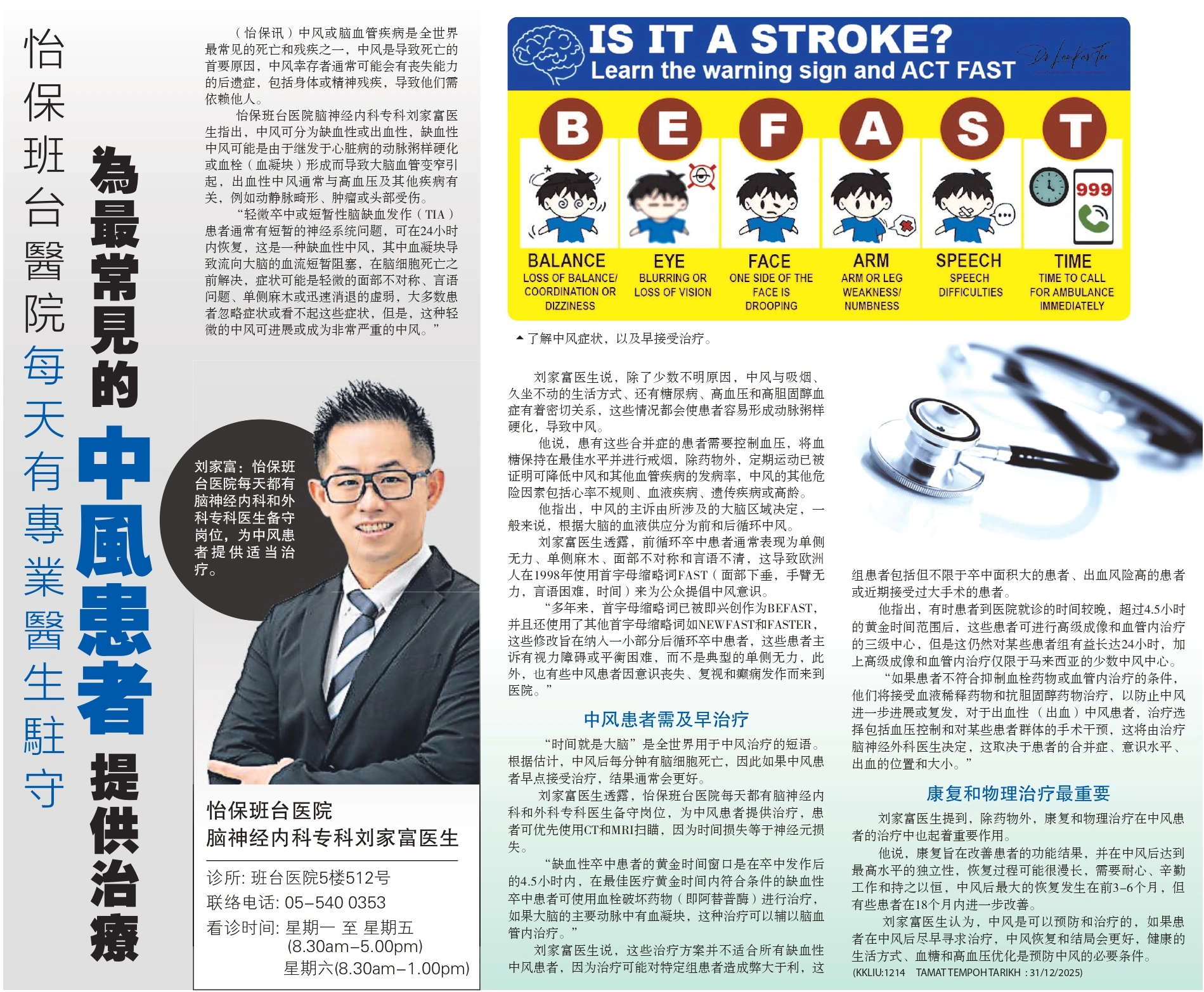

Stroke or cerebrovascular disease remains one of the most common causes of death and disability worldwide. Stroke survivors are commonly left with incapacitating sequelae which include physical or mental disabilities, causing them to be dependent on others.
Stroke is defined as rapidly developing clinical signs of focal (or global) disturbance of cerebral function with symptoms lasting 24 hours or longer or leading to death with no other apparent cause other than that of a vascular origin. A stroke, or "brain attack," occurs when blood circulation to the brain fails.
This can be divided into ischemic or hemorrhagic (bleeding) in origin. Ischemic stroke can be caused by the narrowing of blood vessels in the brain due to atherosclerosis or thrombus (blood clot) formation secondary to heart diseases. Hemorrhagic stroke on the other hand is commonly associated with high blood pressure among other conditions such as arteriovenous malformation, tumor, or head injury. Minor stroke or transient ischemia attack (TIA) patients usually had transient neurological problems that recover within 24 hours. This is a type of ischemic stroke where the blood clot causes a transient blockage of blood flow to the brain which resolved before the brain cells die. The symptoms can be a subtle facial asymmetry, speech problem, unilateral numbness, or weakness that resolved quickly. Most patients ignore the symptoms or look down on such symptoms, however, this minor stroke can progress/become a very severe stroke.
Why would an individual develop a stroke? Apart from the small number of patients with unexplained or unidentified causes, stroke is closely related to smoking, sedentary lifestyles, diabetes mellitus, high blood pressure, and hypercholesterolemia. These conditions predispose the patients to atherosclerosis formation leading to stroke. Thus, patients with these comorbidities need to control their blood pressure, keep their blood sugar within optimum levels and stop smoking. Apart from medications, regular exercise has been proven to reduce the incidence of stroke and other vascular diseases. Other risk factors for stroke include irregular heart rate, blood diseases, genetic diseases, or advanced age.
The presenting complaint for stroke was determined by the area of the brain that is involved. In general, it is divided into anterior (front) and posterior (back) circulation strokes based on the blood supply to the brain. Patients with anterior circulation strokes commonly present with complaints of unilateral weakness, unilateral numbness, facial asymmetry, and slurred speech. This leads to the use of the acronym FAST (facial drooping, arm weakness, speech difficulties, time) by the Europeans in 1998 to create stroke awareness for the public. Over years, the acronym has been improvised to BEFAST and other acronyms were also used such as NEWFAST and FASTER. These modifications aimed to include a small subset of patients with posterior circulation stroke that present with the complaint of having visual disturbances or balance difficulties rather than the classic unilateral weakness. Moreover, there are patients with stroke that come to the hospital with loss of consciousness, double vision, and seizures.
Time is brain! This is the phrase that is being used worldwide for stroke treatment. It is estimated that 1.9 million brain cells die every minute after a stroke hence the outcome is usually better if stroke patients were treated earlier. In Pantai Hospital Ipoh, we have neurologists and neurosurgeons on call every day to treat patients we stroke. Patients are given priority access to our CT and MRI scans as time loss is equal to neuron loss. The golden time window for ischemic stroke patients is within 4.5 hours from the onset of stroke. Within this time window, eligible patients with ischemic stroke can be treated with clot-buster medication, namely alteplase. This treatment can be supplemented with cerebral endovascular treatment if there is a blood clot lodged in the main arteries of the brain. Unfortunately, these treatment options are not for everyone with ischemic stroke as the treatment may cause more harm than benefit for a certain group of patients. This group of patients includes, but is not limited to those who have a large stroke area, patients with high bleeding risk, or patients with recent major surgery. At times, patients present to the hospital late, surpassing the 4.5-hour time frame. Fortunately, some of the tertiary centres that can perform advanced imaging and endovascular treatment may still be beneficial for a certain group of patients for up to 24 hours. This is however limited to a few stroke centres in Malaysia.
If the patient is not eligible for treatment with clot-buster medication or endovascular treatment, then they will be treated with blood-thinning medications and anti-cholesterol medications to prevent the stroke from progressing further or recurring. On the other hand, for patients with hemorrhagic (bleeding) stroke, the treatment options include blood pressure control and surgical intervention for certain groups of patients. This will be decided by the treating neurosurgeons and it depends on the patient’s comorbidities, consciousness level, location, and size of the bleed.
Apart from medications, rehabilitation, and physiotherapy play a major role in the treatment of stroke patients. Rehabilitation aims to improve a patient’s functional outcome and attain the highest level of independence after a stroke. The recovery process can be lengthy and requires patience, hard work, and commitment. The greatest recovery after strokes occurs in the first 3-6 months but there are some patients with further improvement up to 18 months. Multiple neuroprotective medications or supplements were said to be beneficial for the patient after strokes, however, the data from most of the clinical trials were not remarkable and rehabilitation remains the mainstay for stroke recovery.
In conclusion, strokes are preventable and treatable. Stroke recovery and outcome are better if the patient seeks treatment earlier after the stroke. Healthy lifestyles, blood sugar, and high blood pressure optimizations are essentials for stroke prevention.
This article was contributed by Dr. Lau Kar Foo, Resident Consultant Neurologist at Pantai Hospital Ipoh. To know more about where and when to see Dr. Lau Kar Foo at his clinic, click here.

